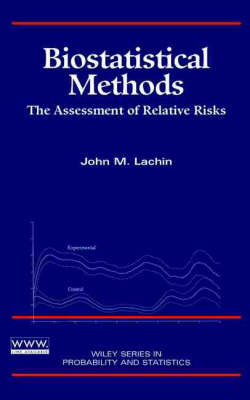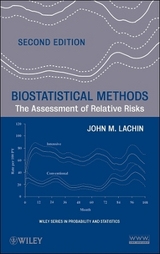
Biostatistics Methods
The Assessment of Relative Risks
Seiten
2000
John Wiley & Sons Inc (Verlag)
978-0-471-36996-7 (ISBN)
John Wiley & Sons Inc (Verlag)
978-0-471-36996-7 (ISBN)
- Titel erscheint in neuer Auflage
- Artikel merken
Zu diesem Artikel existiert eine Nachauflage
This textbook focuses on the assessment of risks and relative risks on the basis of clinical investigations. Basic concepts are developed and core biostatistical methods are derived through both the application of classical mathematical statistical tools and likelihood-based theories.
Comprehensive coverage of classical and modern methods of biostatistics Biostatistical Methods focuses on the assessment of risks and relative risks on the basis of clinical investigations. It develops basic concepts and derives biostatistical methods through both the application of classical mathematical statistical tools and more modern likelihood-based theories. The first half of the book presents methods for the analysis of single and multiple 2x2 tables for cross-sectional, prospective, and retrospective (case-control) sampling, with and without matching using fixed and two-stage random effects models. The text then moves on to present a more modern likelihood- or model-based approach, which includes unconditional and conditional logistic regression; the analysis of count data and the Poisson regression model; and the analysis of event time data, including the proportional hazards and multiplicative intensity models. The book contains a technical appendix that presents the core mathematical statistical theory used for the development of classical and modern statistical methods.
Biostatistical Methods: The Assessment of Relative Risks: Presents modern biostatistical methods that are generalizations of the classical methods discussed Emphasizes derivations, not just cookbook methods Provides copious reference citations for further reading Includes extensive problem sets Employs case studies to illustrate application of methods Illustrates all methods using the Statistical Analysis System(r) (SAS) Supplemented with numerous graphs, charts, and tables as well as a Web site for larger data sets and exercises, Biostatistical Methods: The Assessment of Relative Risks is an excellent guide for graduate-level students in biostatistics and an invaluable reference for biostatisticians, applied statisticians, and epidemiologists.
Comprehensive coverage of classical and modern methods of biostatistics Biostatistical Methods focuses on the assessment of risks and relative risks on the basis of clinical investigations. It develops basic concepts and derives biostatistical methods through both the application of classical mathematical statistical tools and more modern likelihood-based theories. The first half of the book presents methods for the analysis of single and multiple 2x2 tables for cross-sectional, prospective, and retrospective (case-control) sampling, with and without matching using fixed and two-stage random effects models. The text then moves on to present a more modern likelihood- or model-based approach, which includes unconditional and conditional logistic regression; the analysis of count data and the Poisson regression model; and the analysis of event time data, including the proportional hazards and multiplicative intensity models. The book contains a technical appendix that presents the core mathematical statistical theory used for the development of classical and modern statistical methods.
Biostatistical Methods: The Assessment of Relative Risks: Presents modern biostatistical methods that are generalizations of the classical methods discussed Emphasizes derivations, not just cookbook methods Provides copious reference citations for further reading Includes extensive problem sets Employs case studies to illustrate application of methods Illustrates all methods using the Statistical Analysis System(r) (SAS) Supplemented with numerous graphs, charts, and tables as well as a Web site for larger data sets and exercises, Biostatistical Methods: The Assessment of Relative Risks is an excellent guide for graduate-level students in biostatistics and an invaluable reference for biostatisticians, applied statisticians, and epidemiologists.
JOHN M. LACHIN, ScD, is Professor of Statistics and Biostatistics at the George Washington University in Washington, D.C., and Director of the Biostatistics Center in Rockville, Maryland.
Biostatistics and Biomedical Science; Relative Risk Estimates and Tests for Two Independent Groups; Sample Size, Power, and Efficiency; Stratified-Adjusted Analysis for Two Independent Groups; Case-Control and Matched Studies; Applications of Maximum Likelihood and Efficient Scores; Logistic Regression Models; Analysis of Count Data; Analysis of Event-Time Data; Appendices; References; Indexes.
| Erscheint lt. Verlag | 13.6.2000 |
|---|---|
| Reihe/Serie | Wiley Series in Probability & Statistics: Applied Probability & Statistics Section |
| Zusatzinfo | Illustrations |
| Verlagsort | New York |
| Sprache | englisch |
| Maße | 164 x 240 mm |
| Gewicht | 909 g |
| Einbandart | gebunden |
| Themenwelt | Mathematik / Informatik ► Mathematik ► Angewandte Mathematik |
| Mathematik / Informatik ► Mathematik ► Wahrscheinlichkeit / Kombinatorik | |
| Studium ► Querschnittsbereiche ► Epidemiologie / Med. Biometrie | |
| Naturwissenschaften ► Biologie | |
| ISBN-10 | 0-471-36996-9 / 0471369969 |
| ISBN-13 | 978-0-471-36996-7 / 9780471369967 |
| Zustand | Neuware |
| Informationen gemäß Produktsicherheitsverordnung (GPSR) | |
| Haben Sie eine Frage zum Produkt? |
Mehr entdecken
aus dem Bereich
aus dem Bereich
ein überfälliges Gespräch zu einer Pandemie, die nicht die letzte …
Buch | Hardcover (2024)
Ullstein Buchverlage
CHF 34,95



